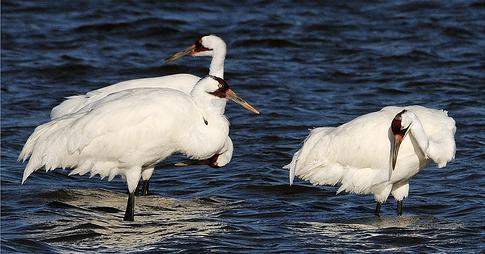
What exactly is a whooping crane?
Anyone can tell that the whooping crane is a bird, but do you know exactly why it's classified as one? Below you will find the complete taxonomic classification of the whooping crane. Enjoy!
Domain: Eukarya
Kingdom: Animalia
Phylum: Chordata
Class: Aves
Order: Gruiformes
Family: Gruidae
Genus: Grus
Species: Grus americana
So now you may be wondering, what do all of these words mean? I will tell you now!
Domain Eukarya: The whooping crane is under this domain because it has a true nucleus and has membrane-bound organelles.
Kingdom Animalia: Species under this kingdom are multi-cellular and heterotrophic, which means that they rely on other organisms to live and do not make their own food or energy. Members in this kingdom are also triploblastic (born with an endoderm, ectoderm and mesoderm). Movement can also be considered a defining factor of this kingdom.
Phylum Chordata: To be classified under this phylum, the organism must, at one point in their life, possess a notocord. These organisms also have a tubular dorsal nerve cord and a tail behind the anus. The whooping crane is further categorized into the Subphylum Vertebrata. Vertebrates have a skull, and a skeleton made of bone, cartilage, or both.
Class Aves: As I mentioned above, anyone can tell that the whooping crane is a bird. Birds have many defining characteristics including a body of feathers, no teeth within the beak and light weight bones that are either hollow or spongy. Birds lay hard-shelled eggs and care for their young for a certain amount of time before leaving them. Birds also have a furcula, which is the chest bone that doesn't allow the compression of the chest cavity while flying, and have a four-chambered heart. Birds are endothermic.
Order Gruiformes: This order contains birds that have no crop and fly with their neck straight. Gruiformes can be found all over the world and can be seen in a variety of sizes, different colors of feathers and different features, but most of them thrive in water-filled, marshy habitats.
Family Gruidae: We're finally getting down to it! Gruidae is the family specifically for cranes. A crane is defined as having a long neck and long legs that are outstretched while in flight. Cranes are opportunistic feeders (more on this on my Nutrition page). Cranes usually have some variation of dance for mating, and live on all continents other than South America and Antarctica. Within the family Gruidae, there are 15 cranes!
Genus Grus: Cranes categorized here are the largest birds within the Family Gruidae. There are ten species within, one of them including the amazing whooping crane! Other species within this genus includes the sarus, sandhill, common (or Eurasian), red-crowned, Siberian, hooded, black-necked, brolga, and white-naped crane. I advise everyone to look up all of these cranes, as they are all just as beautiful as the whooping crane.
Species Grus americana: This is the end of the line. Grus americana is the whooping crane, and translated into english, means American crane.
If you retained any of the above information, you should have discovered that the whooping crane is a marsh-dwelling bird. To find out more about their habitat and where this white bird is found, please visit my Habitat page here, or access my homepage again by clicking here!
